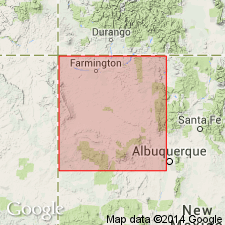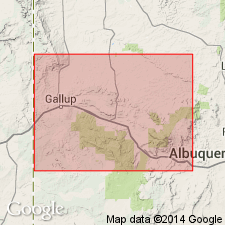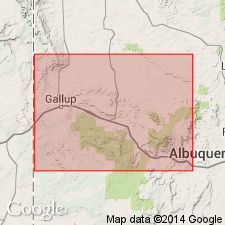
- Usage in publication:
-
- Cleary coal member*
- Modifications:
-
- Named
- Dominant lithology:
-
- Coal
- Sandstone
- Shale
- AAPG geologic province:
-
- San Juan basin
Summary:
Named the basal member of Menefee formation (revised) of Mesaverde group (revised) for Cleary mine in SW1/4 sec 31, T19N, R1W, Sandoval Co, NM in southern San Juan basin. Mesaverde raised to group rank throughout San Juan basin of southwest CO and northwest NM. Was formerly the upper part of Gibson coal member of Mesaverde formation. Composed of coal-bearing sandstone and shale 250-300 ft thick. Overlies Point Lookout sandstone and underlies Allison member of Menefee. More fully described under Gibson coal member in Dane (1936). Small geologic map. Diagrammatic cross section. Of Late Cretaceous age.
Source: GNU records (USGS DDS-6; Denver GNULEX).

- Usage in publication:
-
- Cleary(?) Coal Member*
- Modifications:
-
- Biostratigraphic dating
- AAPG geologic province:
-
- San Juan basin
Summary:
Study of palynomorphs from a sample from the lowest coal in the Upper Cretaceous Menefee Formation (probably the Cleary Coal Member of the Menefee) indicates a biostratigraphic age assignment of Santonian. Sample is from middle of sec 5, T29N, R16W, San Juan Co, NM (San Juan basin). Menefee overlies the main body of the Point Lookout Sandstone (Santonian) and higher strata are not treated in this report. The stage assignments in this report are derived from invertebrate zone fossils found in associated marine rocks. The Hosta Tongue of the Point Lookout Sandstone yields the middle Santonian ammonite CLIOSCAPHITES VERMIFORMIS. The Gibson Coal Member (at the top of the Crevasse Canyon Formation) lies directly below the Hosta Tongue, consequently all the Gibson in the area is probably of Santonian age. By inference, the basal part of the Menefee Formation in this area is about the same age. The uppermost of four pollen zones recognized in the area is confined to the basal Menefee and younger rocks and is characterized by PROTEACIDITES pollen in significant numbers.
Source: GNU records (USGS DDS-6; Denver GNULEX).

- Usage in publication:
-
- Cleary Coal Member
- Modifications:
-
- Areal extent
- AAPG geologic province:
-
- San Juan basin
Summary:
About 25 mi northeast of Gallup, NM near Coal Mine Canyon, Hosta Tongue of Point Lookout pinches out. South of that locality, Gibson Coal Member of Crevasse Canyon Formation and Cleary Coal Member of Menefee Formation cannot be separated. [The stratigraphic restriction by Beaumont and others, 1956 of Gibson to only the lower part of what Sears in 1925 assigned to Gibson, and application of the name Cleary by Beaumont and others to the upper part of what Sears assigned to Gibson has set up a formation contact that cannot be mapped according to these authors.]
Source: GNU records (USGS DDS-6; Denver GNULEX).
For more information, please contact Nancy Stamm, Geologic Names Committee Secretary.
Asterisk (*) indicates published by U.S. Geological Survey authors.
"No current usage" (†) implies that a name has been abandoned or has fallen into disuse. Former usage and, if known, replacement name given in parentheses ( ).
Slash (/) indicates name conflicts with nomenclatural guidelines (CSN, 1933; ACSN, 1961, 1970; NACSN, 1983, 2005, 2021). May be explained within brackets ([ ]).

